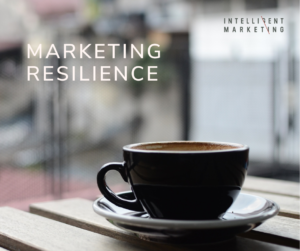Marketing resilience is both a mindset and activities that enable business agility. The blueprint for marketing resilience is more about coming to terms with the ‘new normal’ which is likely to be a prolonged period of uncertainty and constant change. Many businesses have successfully adapted or ‘pivoted’, showing remarkable resilience in order to survive and thrive. But what does it take to have marketing resilience in times of constant change?
The classic reaction to a recession is to cut your marketing spend. But this approach will only deliver very short-term savings, and can cause a devastating impact to organisation. Of course as a marketer I’m going to tell you ‘don’t cut your marketing spend’, but instead look to reposition, focus on a mix of tactics and longer term strategies. Marketing resilience means being effective and focussing your activities in the right place. People behave differently and spend differently in a recession and in times of uncertainty and change.
No matter what your industry sector, here are some steps to consider to make your marketing more agile, adaptable and resilient. And most of all, keep delivering results for your business.
Core components of Marketing Resilience
Instead of thinking about the recession as a negative, embrace the changes. See it as an opportunity to gain visibility and get ahead of your competitors, who aren’t keeping up with their marketing efforts.
- Understand how your customers are changing
- Be prepared to act and respond quickly – be agile
- Focus on digital marketing activities that increase your visibility
- Get creative with your content
- If you can’t measure it you can’t improve
Delivering successful marketing during uncertain times, requires a new approach.
Understand how your customers are changing
Customer and buying behaviours have fundamentally changed during the pandemic, and lockdown. Whoever you target, whether its B2B or B2C, your target audience’s behaviour has changed for good. The way the live and work has shifted, which means their needs and priorities have changed too. It’s vital you understand your target audience, what are their immediate challenges and needs. Talk to your customers, gain deeper understanding of what they are tackling on a day to day basis. Conduct research, be empathetic and use this process to get to know them better than before.
Revisiting and taking a look at your customer segments and personas, go beyond the usual demographics. Think about attributes and behaviours as well as the psychological and emotional considerations. This will also help you with crafting appropriate content.
Be prepared to act and respond quickly – be agile
Resilient marketing needs to be agile and respond authentically and effectively to changing circumstances. That means adapting quickly to new situations and context as a business, but understanding the same for your customers and prospects.
Messaging needs to be considered and empathetic, but also think about being ‘more generous’, in terms of support, guidance and tips. A great article from Harvard Business Review gives guidance on cultivating a nimble approach and adapting to new ways of working, to keep delivering.
Focus on digital marketing activities that increase your visibility
More than ever businesses are revisiting their online presence and you should do the same. This means increasing your visibility. Look at your website through the eyes of your visitors, be objective and critical. If you’ve never visited your website and don’t know what your business does or how your business helps, make some changes. Look at those visitor journeys on desktop and mobile. Check website performance and look at your SEO.
Being consistently active on social media can really contribute to increasing your digital visibility. Take the time to review which platforms are working best for you. What type of content and posts are engaging your audiences the most. Be open to taking a different approach with your social media tactics and strategy. Focus on what’s working, but understanding why it’s working if you can.
Get creative with your content
With so much content relating to COVID-19, audiences have become a little ‘war weary’ and looking for feel-good content that helps alleviate daily anxiety. Consider content that’s empathetic, helpful and authentic, avoid the sales pitch.
Content marketing is a core component of resilient marketing, so consider creative ways to generate content which will help with tight budgets, but also help with authenticity. Audiences are comfortable with a more natural and raw approach to video content, so capitalise on creating video content from ‘live interview’, video with smartphones. This approach will help with demand and managing the cost of production.
Repurpose your content. Take stock of what you have and divide your blogs into several videos. Create video tips and help for your audiences. Convert a long from article into a listicle. Use your subject matter experts for interviews and contributions – create from within your team.
If you can’t measure it you can improve
This often quoted saying by management thinker Peter Drucker, highlights the need for measurement and decisions based on accurate data. This may seem very obvious, but measurement and feedback loops are key to success.
Using your data and insights to determine how well your marketing activity is performing has never been more important. Resilient marketing means measurement, analysis and adjusting activities as needed.
More than ever, marketing is responsible for the early stages of the buying journey. Therefore understanding and measuring marketing activity performance is essential as well as how it contributes to your sales outcomes.
Marketing resilience is achievable
Marketing resiliency in uncertain and changing times is achievable. Being agile is a significant key to success. Implementing a mix of practical and tactical strategies is crucial to successfully navigating a constantly changing market, where buyer behaviours are also shifting.







